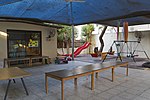Prince Mohammed bin Abdullah Al Faisal Stadium
1987 establishments in Saudi ArabiaBuildings and structures in JeddahFootball venues in Saudi ArabiaMiddle Eastern sports venue stubsMulti-purpose stadiums in Saudi Arabia ... and 2 more
Saudi Arabian building and structure stubsSaudi Arabian sport stubs
Prince Mohammed bin Abdullah Al Faisal Stadium, previously known as the Prince Sultan bin Fahd Stadium, is a multi-purpose stadium in Jeddah, Saudi Arabia. The stadium has a capacity of 10,000 people and opened in 1987. In October 2011 it was renamed as Prince Mohammed bin Abdullah Al Faisal Stadium as a tribute to Prince Mohammed bin Abdullah, one of the former presidents of Al Ahli club. It is used mostly for football matches and is the home stadium of Al Ahli club.
Excerpt from the Wikipedia article Prince Mohammed bin Abdullah Al Faisal Stadium (License: CC BY-SA 3.0, Authors).Prince Mohammed bin Abdullah Al Faisal Stadium
Prince Saud Al Faisal Street, Jeddah
Geographical coordinates (GPS) Address Website Nearby Places Show on map
Geographical coordinates (GPS)
| Latitude | Longitude |
|---|---|
| N 21.567158 ° | E 39.173727 ° |
Address
مركز جدة العلمي
Prince Saud Al Faisal Street
23442 Jeddah
Makkah Region, Saudi Arabia
Open on Google Maps




